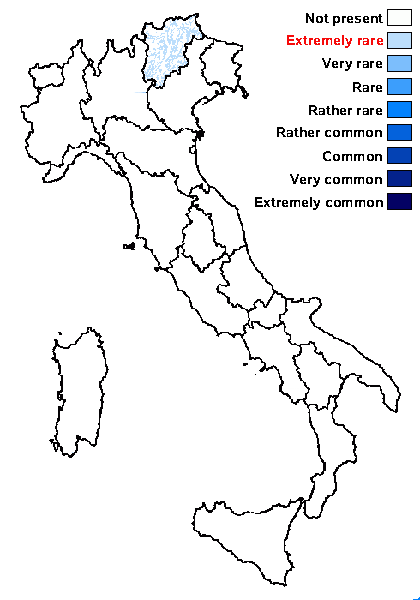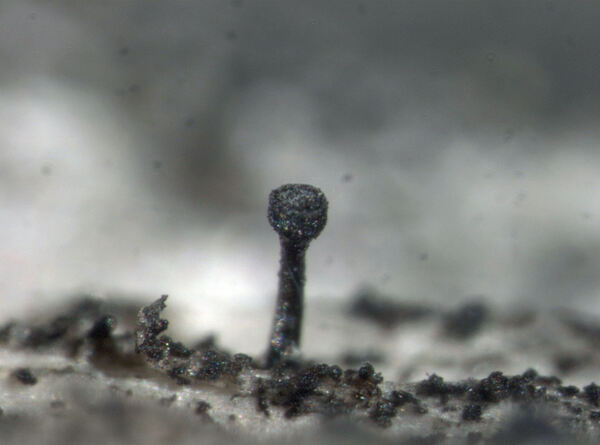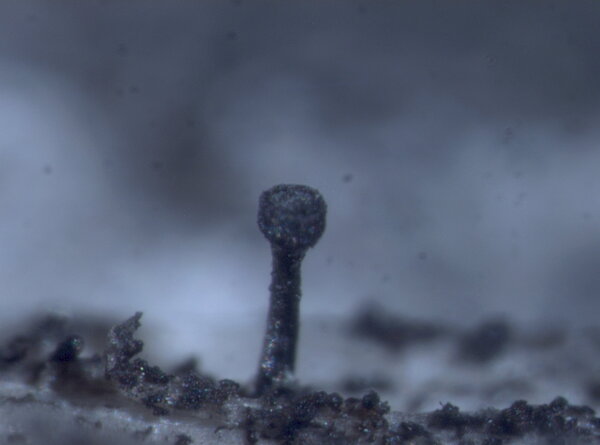Calicium denigratum (Vain.) Tibell
Bot. Notiser, 129, 2: 132, 1976. Basionym: Calicium curtum var. denigratum Vain. - Medd. Soc. Fauna Flora Fenn., 6: 95, 1881
Synonyms:
Distribution: N - TAA (Ravera & al. 2023).
Description: Thallus crustose, endosubstratic, thin and poorly evident. Apothecia long-stalked, pin-like, slender, epruinose, shining black. Stalk 0.7-1.3 mm high, 0.06-0.09 µm thick, of sclerotized, dark, irregularly interwoven hyphae, the outer layer of non-sclerotized, prosoplectenchymatous hyphae, covered with a thin, transparent gelatinous sheath, the central part dark brown, of irregularly intertwined, sclerotized, thick-walled, 3-4 µm thick hyphae. Capitulum 0.2-0.3 mm across, slightly bell-shaped, with an exciple of sclerotized, dark brown, 3-5 µm thick cells; mazaedium well developed, black; paraphyses cylindrical, formed singly, dissolving early; hypothecium dark brown, 55-70 µm high, with a flat to slightly convex upper surface, of dark brown, sclerotized, intertwined hyphae. Asci cylindrical, formed singly, dissolving early with uniseriate ascospores. Ascospores 1-septate, dark brown, ellipsoid, 11-14 x 6-8 µm, with an irregularly and coarsely areolate wall. Photobiont chlorococcoid. Spot tests: thallus K-, C-, KC-, P-; ascomata I- in all parts. Chemistry: without lichen substances. Note: on decorticated stumps and snags in montane-subalpine coniferous forests, with several records from the Eastern Alps outside the Italian territory; known from South Tyrol, but perhaps more widespread in the Alps.
Growth form: Crustose
Substrata: lignum
Photobiont: green algae other than Trentepohlia
Reproductive strategy: mainly sexual
Commonnes-rarity: (info)
Alpine belt: absent
Subalpine belt: absent
Oromediterranean belt: absent
Montane belt: extremely rare
Submediterranean belt: absent
Padanian area: absent
Humid submediterranean belt: absent
Humid mediterranean belt: absent
Dry mediterranean belt: absent

Predictive model
Growth form: Crustose
Substrata: lignum
Photobiont: green algae other than Trentepohlia
Reproductive strategy: mainly sexual
Commonnes-rarity: (info)
Alpine belt: absent
Subalpine belt: absent
Oromediterranean belt: absent
Montane belt: extremely rare
Submediterranean belt: absent
Padanian area: absent
Humid submediterranean belt: absent
Humid mediterranean belt: absent
Dry mediterranean belt: absent

Predictive model
 INDEX FUNGORUM
INDEX FUNGORUM
 GBIF
GBIF
 DOLICHENS
DOLICHENS




